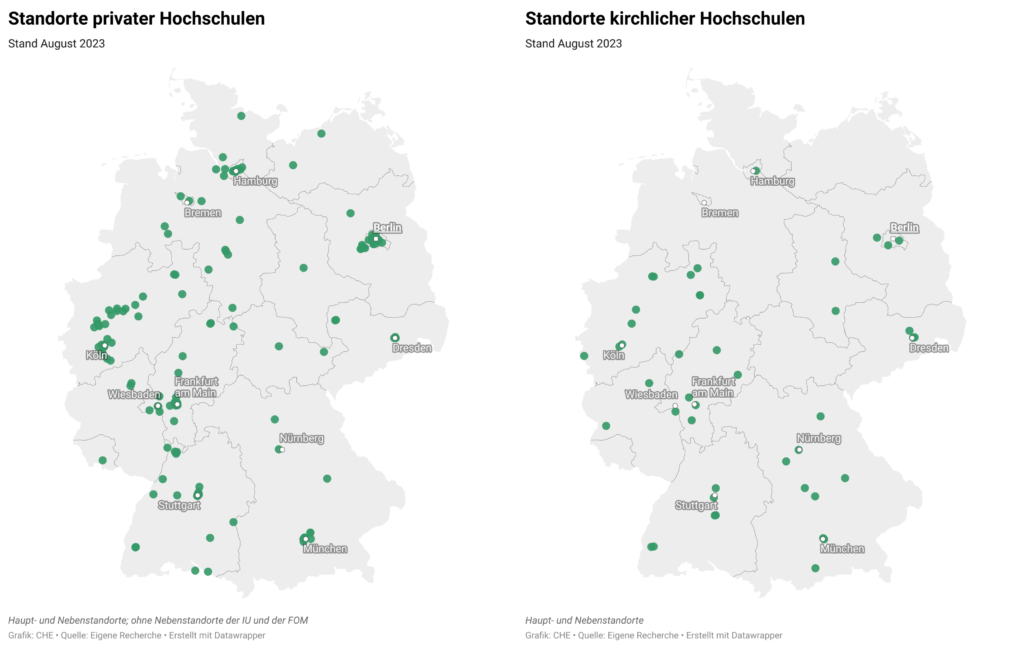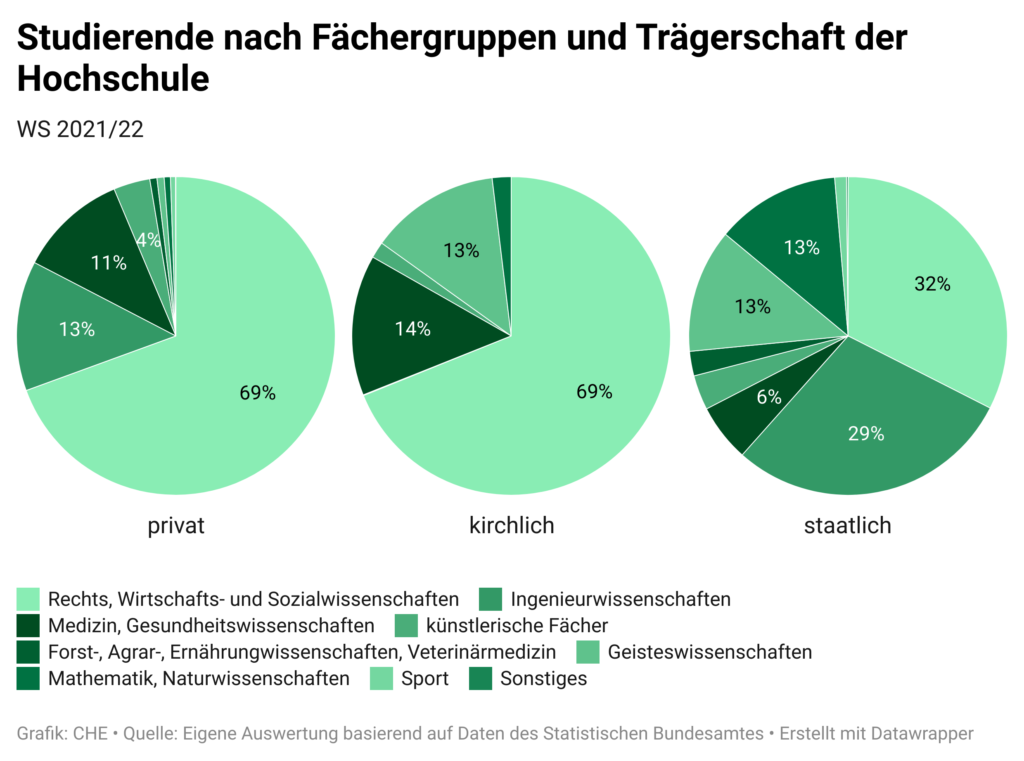 Mehr als die Hälfte der Standorte von privaten Hochschulen befinden sich in Großstädten wie Berlin | Foto: Jonas Tebbe / Unsplash
Mehr als die Hälfte der Standorte von privaten Hochschulen befinden sich in Großstädten wie Berlin | Foto: Jonas Tebbe / UnsplashPrivate higher education institutions (HEIs) are experiencing a boom. Two of the three largest HEIs in Germany are now privately funded. However, the majority of private HEIs have fewer than 1,000 students, are located in a large city and offer a narrow range of programmes. This is the conclusion of a DataCHECK conducted by CHE, which compared the profiles of state, faith-based and private HEIs. The publication is part of the nsh-inno project, which analyses the transfer contributions made by private and faith-based HEIs according to the type of HEI and the regional environment.
Compared to state-run HEIs, non-state and especially private HEIs are currently experiencing a boom in Germany. In the last winter semester 2022/23, 12 per cent of all students were enrolled at a private institution. Of the current 427 HEIs in Germany, 64 per cent are run by the state, 27 per cent are privately funded and 9 per cent are funded by the church.
Private HEIs are a new phenomenon in the German higher education system. While some state HEIs, such as Heidelberg University and the University of Cologne, have been in existence since the Middle Ages, and many of the church-maintained HEIs also have a long history, two-thirds of the private HEIs listed in the Higher Education Compass provided by the German Rectors’ Conference (HRK) in August 2023 were founded in the new millennium, six of them after 2020.
This is one of the reasons why private and ecclesiastical HEIs, like other non-state HEIs, are presently being analysed as part of a current BMBF funding line, which is also funding the nsh-inno project run jointly by CHE and the Fraunhofer Institute for Systems and Innovation Research ISI. The project focuses on the transfer contributions of non-state HEIs. The latest CHE DataCHECK now highlights the differences between state, private and faith-based HEIs. The analysis was based on data from the Federal Statistical Office of Germany and the HRK’s Higher Education Compass.
Both state and private HEIs are represented in all German federal states. Faith-based HEIs, on the other hand, exist in only ten federal states, mainly in south-west Germany. Faith-based and state universities can be found in cities of different population sizes. There is a strong concentration of private HEIs in large cities. More than half of them are located in cities with over half a million inhabitants. “Private HEIs specifically open branches where there is a high demand from students, and these are, of course, mainly in large cities or urban centres,” was how Cort-Denis Hachmeister, CHE’s Senior Expert Data Analysis, explained the disparity in size.

Diagrams: Sites of private HEIs Sites of faith-based HEIs
The number of students per HEI also varies considerably. “While the majority of state HEIs have more than 5,000 students each, the majority of private HEIs have triple-digit student numbers,” highlighted Cort-Denis Hachmeister, qualifying this statement as follows: “At the same time, two private institutions are now among the top three HEIs in Germany in terms of student population.” Faith-based HEIs are often even smaller than private ones: “About 40 per cent of faith-based HEIs have fewer than 100 students on campus,” said Hachmeister.
Both private and faith-based HEIs often concentrate on a narrow range of subjects, especially in the fields of law, economics and social sciences, as well as medicine and health sciences, or theology and church music in the case of ecclesiastical HEIs. About 80 per cent of private HEIs and about 45 per cent of church-run HEIs are universities of applied sciences. They rarely offer more than 20 different degree programmes, while over 60 state HEIs (the majority of which are universities) offer more than 100 degree programmes.

Diagram: Students by subject group and university funding body
DataCHECK 4/2023 “Private und kirchliche Hochschulen” (Private and faith-based higher educations institutions) is part of a preliminary study for the project entitled nsh-inno – Nicht-staatliche Hochschulen im Innovationssystem-Kontext (Non-state higher education institutions (HEIs) in the innovation system context).
The next steps of the nsh-inno research project will be to investigate whether these characteristics also have an impact on the transfer activities of HEIs. To this end, non-state HEIs will first be clustered on the basis of the aspects presented here and others, and then the transfer activities of the individual clusters will be explored in greater detail.
“The analysis will show whether non-state HEIs also excel in areas beyond student recruitment, and approach knowledge transfer in their own unique ways,” explained Hendrik Berghäuser from ISI Fraunhofer in anticipation of the months ahead.
The collaborative research project, launched in June 2023, is funded by the Federal Ministry of Education and Research (BMBF) under funding code 16NISTA14B and will run for three years.
DatenCHECK 4/2023: Private und kirchliche Hochschulen 26. October 2023 0.00 KB 10788 downloads
Hachmeister, Cort-Denis: DatenCHECK 4/2023: Private und kirchliche Hochschulen, CHE,...Wo stehen die privaten Hochschulen? (Interview Cort-Denis Hachmeister im Deutschlandfunk 26.10.2023) 27. October 2023 0.00 KB 10814 downloads
Cort-Denis Hachmeister äußert sich im Interview mit dem Deutschlandfunk zu den...
Bildquelle: Jonas Tebbe / Unsplash
